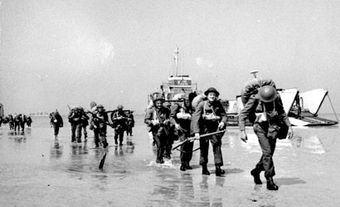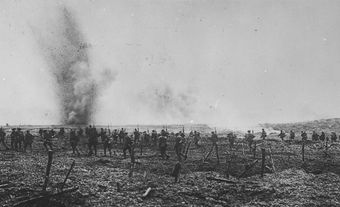Milton Fowler Gregg, VC, PC, OC, CBE, MC and Bar, educator, soldier, university president, politician, diplomat (born 10 April 1892 in Mountain Dale [now Snider Mountain], NB; died 13 March 1978 in Fredericton, NB). Gregg was awarded the Victoria Cross in 1919 for his actions in the closing days of the First World War, having previously been awarded two Military Crosses. After service in the Second World War, Gregg became president of the University of New Brunswick. He then become a Liberal cabinet minister and diplomat.

Early Life and Education
Milton Gregg was the son of George Gregg, a farmer, and Elizabeth Myles. He attended his local public school and obtained his teaching certificate from the Provincial Normal School in Fredericton. In 1910, when he was 18, he joined the 8th Princess Louise’s New Brunswick Hussars, a local militia regiment. He graduated from Acadia University in Wolfville, Nova Scotia, with a Bachelor of Arts degree and attended Dalhousie University in Halifax. Gregg then taught school in his home province for three years.
First World War
Milton Gregg enrolled in the 13th (Royal Highlanders) Battalion of the Canadian Expeditionary Force as a private in September 1914. He sailed to Britain with the First Canadian Contingent later that month. In February 1915, the battalion moved to France, where Gregg served as a stretcher bearer and was wounded twice at the Battle of Festubert.
Gregg was sent to a hospital in Britain to recover, where he was recommended for a commission. He was sent to the Imperial Officers’ Training School and was commissioned as a lieutenant in 1916. Gregg returned to France and was posted to the Royal Canadian Regiment (RCR), where he served as a platoon commander in C Company.
Military Crosses
On 8 June 1917, the regiment’s C and D Companies participated in a three-battalion night trench raid during the Battle of Lens. As the soldiers moved forward, Milton Gregg led a successful flank attack against a German machine gun holding up the advance. Ninety minutes after the raid began, the RCR began to withdraw. During the retreat, Gregg carried a seriously wounded fellow officer back to RCR lines under heavy fire, despite being wounded himself. Gregg was awarded the Military Cross (MC) for his actions.
On 26 August 1918, Gregg led a bombing attack against two German machine-gun posts in Monchy-le-Preux during the Battle of the Scarpe. Although wounded, he carried on and killed the crews of both guns. Gregg’s platoon was soon cut off, but he linked up with RCR soldiers on his left flank. He then successfully fought off a German counterattack. These actions resulted in the award of a second MC to Gregg.
Courage at Cambrai
On 8 August 1918, the Battle of Amiens marked the start of the country’s most significant feat of arms in its history, known as “Canada’s Hundred Days.” During this period, Canadian and Allied armies pushed the Germans back in a series of battles that ended in Belgium. This period saw many of the war’s key battles, from Amiens to Mons on 11 November.
By late September, the Canadian Corps had to cross the Canal du Nord, occupy Bourlon Wood and then capture the city of Cambrai. (See Battle of Cambrai.) The attack began on 27 September, and Canadian soldiers quickly crossed the canal, seized Bourlon Wood and came up against the last trench line in the area, the heavily defended Marcoing Line.
On 28 September, thick barbed wire and strong enemy machine-gun fire from both flanks held up the RCR at the Marcoing Line. Milton Gregg wormed his way forward to the wire, found a gap large enough for one man at a time and directed his soldiers into a German trench. He next led his men in an attack with bombs (as hand grenades were then called) along the German trench.
When the enemy counterattacked, the situation quickly became critical once Gregg’s men ran out of bombs. Although wounded, Gregg returned to his own lines under heavy fire to pick up more bombs. He rejoined his men, now reduced in numbers, and led them against the German trenches, despite being wounded a second time.
By the time Gregg cleared the German trench, he had personally killed or wounded 11 enemy soldiers and captured 25 prisoners and 12 machine guns. On 30 September, he repeated this feat and led another attack against enemy positions. This time Gregg was so severely wounded, he had to be evacuated and hospitalized.
For his courage and determination, Gregg was awarded the Victoria Cross. He received it from King George V at Buckingham Palace on 26 February 1919.

Life Between the Wars
Milton Gregg married Dorothy Alward in August 1919, not long after he returned to Canada. He then worked for the Soldiers Settlement Board, the Halifax Herald and other businesses. Gregg also maintained his military connections and remained in the militia. From February 1934 to August 1945, he was sergeant-at-arms of the House of Commons. During his absence in the Second World War (see below), the clerk of the House of Commons replaced him. In August 1936, Gregg commanded the guard of honour at the unveiling of the Vimy Ridge National Memorial by King Edward VIII.
Second World War
When the Second World War broke out in September 1939, Milton Gregg reenrolled in the Permanent Force and became second-in-command of the RCR. He went overseas with the unit in December 1939 and in February 1940 was appointed commanding officer of the West Nova Scotia Regiment (WNSR). Gregg was soon promoted lieutenant-colonel and led the unit through a rigorous training schedule.
In late October, Gregg became ill and after a lengthy period of recovery returned to the WNSR in April 1941. The next month, he was promoted colonel and appointed as commander of the Canadian Officer Cadet Training Unit in London. Gregg returned to Canada in 1942 and commanded the Officers’ Training Centre (Eastern Canada) in Brockville, Ontario.
Gregg was promoted brigadier in 1943 and appointed chairman of the Officers’ Selection Board. He then went on to command the Canadian Infantry School in Vernon, British Columbia, followed by the Canadian Infantry Training Centre (Reinforcement) at Sussex, New Brunswick. Among his responsibilities was the training of CANLOAN officers, a scheme that loaned 673 surplus Canadian Army junior officers to the British Army.

Life Postwar
In the summer of 1944, University of New Brunswick (UNB) officials invited Milton Gregg to become the university’s president. From 1944 to 1947, he successfully handled the influx of veterans who enrolled in studies after the Second World War, significantly enlarging the student population at UNB, as at other universities. Gregg extensively reorganized university administration and made other organizational changes. In December 1945, while UNB president, his appointment as a Commander of the Order of the British Empire (CBE) for his wartime service was also announced.
In 1947, Prime Minister William Lyon Mackenzie King personally asked Gregg to join his cabinet. In a by-election called due to the death of the incumbent, he was elected as the Liberal Member of Parliament for the New Brunswick riding of York-Sunbury. Gregg served as Minister in three consecutive portfolios: Fisheries (2 September 1947 to 18 January 1948), Veterans Affairs (19 January 1948 to 6 August 1950) and Labour (7 August 1950 to 20 June 1957).
Gregg also served as a diplomat. He represented the United Nations in Iraq (1958–59), UNICEF in Indonesia (1960–63) and Canada at UN headquarters in New York. In December 1959, while he served with the UN, Gregg’s wife died; in 1964, he married Erica Deichman. One of Gregg’s final public duties was as Canadian High Commissioner to British Guiana as it transitioned to the independent state of Guyana (1964–67).
In December 1967, Gregg became one of the first recipients of the newly created Order of Canada, which was created to honour the centennial of Confederation. The honour recognized his service as a soldier and public servant.
Gregg became president of the Canadian Council for International Co-operation (today Cooperation Canada) when it was founded in 1968. He was also the first honorary president of the Conservation Council of New Brunswick when it was established in 1969. Gregg had a particular interest in the health of the Saint John River.
On 24 December 1978, Gregg’s Victoria Cross and his other medals were stolen at a function at the RCR Museum in London, Ontario. They have never been recovered.
Legacy
- Gregg Barracks, 2nd Battalion, the Royal Canadian Regiment, 5th Canadian Support Division Base Gagetown
- Gregg Trophy CAF Small Arms Competition for highest pistol score (1978)
- RCR Milton Fowler Gregg VC Memorial Bursary for a UNB student showing promise in environmental management or international affairs
- Brig. Milton F. Gregg VC CANLOAN Memorial, Oromocto, New Brunswick
- Milton F. Gregg Award, Conservation Council of New Brunswick (1981)
- The Honourable Brigadier Milton F. Gregg Memorial, 5th Canadian Support Division Base Gagetown (1983)
- The Brigadier Milton F. Gregg, VC, Centre for the Study of War and Society, University of New Brunswick (2006)

 Share on Facebook
Share on Facebook Share on X
Share on X Share by Email
Share by Email Share on Google Classroom
Share on Google Classroom















